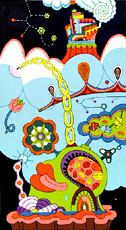|

Comment
on this story
What:
10th Artist-in-Residence Biennial
Where:
Ewing Gallery, 1715 Volunteer Boulevard
When:
Thru Feb. 3, with a lecture by artist Sam Gordon tonight, Jan. 10, in the Art and Architecture Building Room 109 at 7 p.m. Call 974-3200 for information.
|
|

After another two years, UT spotlights its artist-in-residence program
by Heather Joyner
At a Whitney Museum biennial exhibit some time ago, I realized that the birth years listed for participating artists were creeping closer to mine. My image of older, mostly male art superstars was getting a bit tired anyhow, but I realized I'd soon have to take the work of my own generation seriously. I'd have a firmer grasp of younger artists' references, yes, but I might also know enough to admire them less. My door to art hero worship was slamming shut, and I wasn't sure I wanted to be sequestered with my own kind.
UT's biennial show opening today features some of my contemporaries: four visiting artists who reveal a strong interest in what painter Carrie Moyer refers to as '60s and '70s "pop culture detritus." Like the original Pop Art crowd—comprised of Roy Lichtenstein, Claes Oldenburg, James Rosenquist, and others—these thirty-something-year-olds are fascinated with the values and visual symbols dominating their youth. But their symbols are different, as this new crop's cultural bedrock has arguably been "rockier" than that of their predecessors. After all, upheavals throughout the latter part of the 20th Century have produced a climate complex enough that former Weather Underground spokeswoman Bernardine Dohrn could now be your brother's law professor at Northwestern. Despite reflecting a tangle of early influences, the art on display nevertheless holds together, grappling with a perceived loss of innocence. I just wish there were more pieces on display.
In addition to Moyer, we have Elisabeth Condon, Sam Gordon, and Jovi Schnell to consider. All except Gordon have already done a semester-long teaching stint here, exposing UT students to big city working artists' perspectives they might not otherwise run across. For almost two decades, that's been the salient point of UT's Artist-in-Residence or A.I.R. Program, although it serves other purposes. Personally, I think it's a great idea. Given the Ewing Gallery's daring focus on diversity in recent years, exhibited works by the aforementioned artists may not deliver as much punch as did previous A.I.R. fare, but they still represent current art trends and challenge our sense of what's happening here versus elsewhere.
Condon's subject matter could be anywhere. Using truly creepy images of dolls as metaphors for the helplessness and perils of childhood, Condon casts toys in disturbing roles. Three of her nine canvases are round, and four ink drawings are tacked to the wall. All feature a variety of babydolls along with Raggedy Ann and Andy, doll houses, and other girlhood ephemera.
In Condon's "Angry Baby Dream Alone," a bloated-looking doll with flower child eyes lies in the painting's foreground, a bonneted African American doll at her side. As in Edouard Manet's "Olympia," the black figure is secondary but memorable. No matter what we make of the piece, Condon's handling of the paint itself is quite impressive. Her technical ability and somewhat traditional approach combined with lurid imagery (i.e., a sock monkey apparently about to take a crawling blonde doll from behind) prove particularly unsettling. Says Condon, "The nuclear family becomes a visual structure to manipulate in the pursuit of emotional truth." Herein, that "nuclear family" has doll "daughters" with green hair and what appear to be festering sores. Yikes.
Gordon, like Condon, uses "psychedelic color" and odd juxtapositions to jar his audience. Works on paper, paintings, and color photographs play with the meaning of icons like the Star of David, forcing us to acknowledge their impact. Placed in a visually beautiful context, chains, a noose, and other items associated with violence appear comfortable alongside religious symbols. It's a little scary. Gordon has remarked that such pieces can function as personal talismans and he acknowledges that viewers must decipher a private lexicon-of-sorts.
Moyer's paintings, often alluding to mass media, are less "narrative" than works by Condon and Gordon. But her hippie commune upbringing—a background similar to Schnell's—could explain her highly political bent. Moyer founded DAM! (Dyke Action Machine!) in 1991 with photographer Sue Schaffner (a.k.a. "Girl Ray"), creating a public art project that's "inserted lesbian images into recognizably commercial contexts" in order to "dissect mainstream advertising." DAM! has targeted people via everything from the World Wide Web and interactive phone lines to matchbook covers. Moyer's activism, then, is a family tradition. But with only five mixed media pieces in the show, it's difficult to expand on Moyer's "counterculturalism." Likewise, I cannot say much about Schnell's three canvases, except that they resemble what Dr. Seuss might have produced had he attempted to illustrate his characters' innards.
So what, then, do viewers end up with? As I said, there could be more stuff for us to look at. Given Schnell's limited number and the fact that Moyer's selection predates what she produced while in Knoxville (perhaps because her solo show at The Gallery@Green Street in New York premieres tomorrow), the Ewing is a bit like an unsatisfying sandwich—hearty hunks of bread with little in between. Works by Condon and Gordon are relatively numerous and substantial, yet the space they inhabit feels a tad naked overall. I'd like to see this kind of exhibit set itself apart from non-A.I.R. exhibits by including photographs or videotape of the artists working with students, presenting slides, etc. Gordon's slide lecture this evening is presumably just one in a series of such events, but it's the only presentation held in tandem with the biennial's opening itself. The show would be more significant if we could better feel the presence of all four artists and have a clearer notion of their impact on UT's art department.

January 10, 2002 * Vol. 12, No. 2
© 2002 Metro Pulse
|